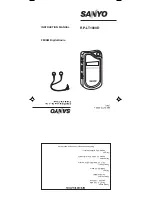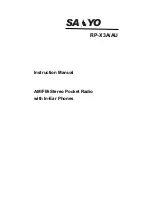
3 - 7
3-4 DSC CIRCUITS
3-4-1 DSC BANDPASS FILTER AND RF AMPLIFIER
CIRCUITS (MAIN UNIT)
The RF circuit filters out-of-band signals and amplifiers sig-
nals within the range of frequency coverage.
(1) 2–7 MHz signals
The signals from the antenna connector (J2101) pass
through the bandpass filter (L2201, L2202, L2207, L2210,
L2213, L2216, L2219, L2220, L2225, L2228, L2231, C2201,
C2204, C2207, C2210, C2213, C2216, C2219, C2222,
C2225, C2228, C2234, C2240) to obtain desired 2–6 MHz
signals and suppress any undesired signals.
(2) 8 MHz signals
The signals from the antenna connector (J2101) pass
through the bandpass filter (L2204, L2208, L2211, L2214,
L2217, L2221, L2222, L2229, L2232, C2202, C2205,
C2208, C2210, C2211, C2214, C2217, C2220, C2223,
C2226, C2236, C2241) to obtain desired 8 MHz signals and
suppress any undesired signals.
(3) 12 MHz signals
The signals from the antenna connector (J2101) pass
through the bandpass filter (L2235–L2242, L2244, L2245,
C2229, C2235, C2237, C2239, C2243–C2250,
C2252–C2254, C2263, C2264) to obtain desired 12 MHz
signals and suppress any undesired signals.
(4) 16 MHz signals
The signals from the antenna connector (J2101) pass
through the bandpass filter (L2205, L2206, L2209, L2212,
L2215, L2218, L2223, L2224, L2230, L2233, C2203, C2206,
C2209, C2212, C2215, C2218, C2221, C2224, C2226,
C2227, C2238, C2242) to obtain desired 16 MHz signals
and suppress any undesired signals.
The filtered signals are amplified at the RF amplifiers
(Q2301, Q2302), and then applied to the 1st mixer circuit
(D2301).
3-4-2 DSC 1ST MIXER AND 1ST IF CIRCUITS
(MAIN UNIT)
The 1st mixer circuit converts the received signal into a fixed
frequency of the 1st IF signal with a PLL output frequency.
By changing the PLL frequency, only the desired frequency
will pass through a crystal filter at the next stage of the 1st
mixer.
The signals from the RF circuit are mixed at the 1st mixer
(D2301) with a 1st LO signal coming from the PLL circuit to
produce a 10.7 MHz 1st IF signal.
The 1st IF signal is applied to the crystal bandpass filters
(FI231) to suppress out-of-band signals. The filtered 1st IF
signal is amplified at the 1st IF amplifiers (Q2401, Q2501),
then applied to the 2nd mixer circuit (IC2701, pin 3).
3-4-3 DSC 2ND IF AND DSP CIRCUITS
(MAIN AND DSP UNITS)
The 2nd mixer circuit converts the 1st signal into a 2nd IF
signal. A double conversion superheterodyne system (which
converts receive signals twice) improves the image rejection
ratio and obtain stable receiver gain.
The 1st IF signal from the 1st IF amplifiers is applied to the
2nd mixer IC (IC2701, pin 3), and is mixed with the 2nd LO
signal to the converted into a 12 kHz 2nd IF signal.
The 12 kHz 2nd IF signal from the 2nd mixer (IC2701, pin 5)
is applied to the 2nd IF amplifier (IC2702, pin 3), and then
passes through the low-pass filter (IC2702, pins 5, 7). The
signal is applied to the DSP unit as the “DSPI2” signal.
The signal is amplified at the differential amplifier (DSP unit;
IC601), and is then applied to the A/D converter secition in
the CODEC IC (DSP unit; IC501). At the same time, the con-
verted signal is level-shifted 5 V to 3.3 V in the IC (DSP unit;
IC501).
The level-shifted signal is applied to the DSP IC (DSP unit;
IC301) for the digital IF filter, demodulator and noise reduc-
tion, etc.
The output signal from the DSP IC is applied to the D/A con-
verter section in the CODEC IC (DSP unit; IC501) to convert
into the analog audio signals. Also the signals are level-shift-
ed 3.3 V to 5 V at the level converter section in the IC.
The level-shifted audio signals are passed through the
active filter (IC701b), and then applied to the MAIN unit via
the J1102 (pin 21) as the “DSPO2” signal.
3-4-4 DSC AGC CIRCUIT (DSP AND MAIN UNITS)
The receiver gain is determined by the voltage on the AGC2
line from the DSP unit. The D/A converter for the AGC
(IC102) supplies control voltage to the AGC2 line and sets
the DSC receiver gain.
The 3rd IF signal from the CODEC IC (IC501) is detected at
the AGC detector section in the DSP IC (IC301). The output
signal from the DSP IC is level-shifted at the level converter
(IC101) and applied to the D/A converter (IC102). The AGC
voltage is amplified at the buffer amplifier section in the
IC102 and applied to the MAIN unit to control the AGC2 line.
When receiving strong signals, the detected voltage increas-
es and the AGC2 voltage decreases. As the AGC2 voltage
is used for the bias voltage of the IF amplifiers (MAIN unit;
Q2401, Q2501), IF amplifier gain is decreased.
3-5 FRONT UNIT (RC-25)
3-5-1 LCD CIRCUIT (DISPLAY AND CONNECT
BOARDS)
The LCD (CONNECT board; DS8220) is controlled by the
LCD driver (CONNECT board; IC8240) via the drive signals
(CL1, RES, CS, RS, WR, RD, DB0–DB7) from the display
board. The LCD’s back light employs 24 LED
(DS8300–DS8323). The LED are controlled by dimmer
(Q8300, Q8301) and dimmer controller (IC8280) circuits.
3-5-2 MICROPHONE CIRCUIT (DISPLAY BOARD)
The AF signals from the microphone are amplified at the AF
amplifier (IC8280) via the “MIC” signal. The signal is applied
to the IC-M802’s main unit through the J8903 via the “MI”
signal.
Содержание IC-M802
Страница 1: ...MF HF MARINE TRANSCEIVER iM802 SERVICE MANUAL ...
Страница 27: ...4 10 Transmit peak and total gain adjustment L706 IC M802 TOP VIEW CH ENT RC 25 FRONT PANEL ...
Страница 60: ... BOTTOM VIEW MAIN UNIT 8 8 ...
Страница 62: ... BOTTOM VIEW FILTER BOARD 8 10 ...
Страница 65: ...8 3 6 DRIVER BOARD TOP VIEW 8 13 GND VARO VARI to PA unit J6411 8 3 7 VARISTOR 1 BOARD ...
Страница 78: ......
Страница 79: ...1 1 32 Kamiminami Hirano ku Osaka 547 0003 Japan S 13901HZ C1 C 2002 Icom Inc ...














































